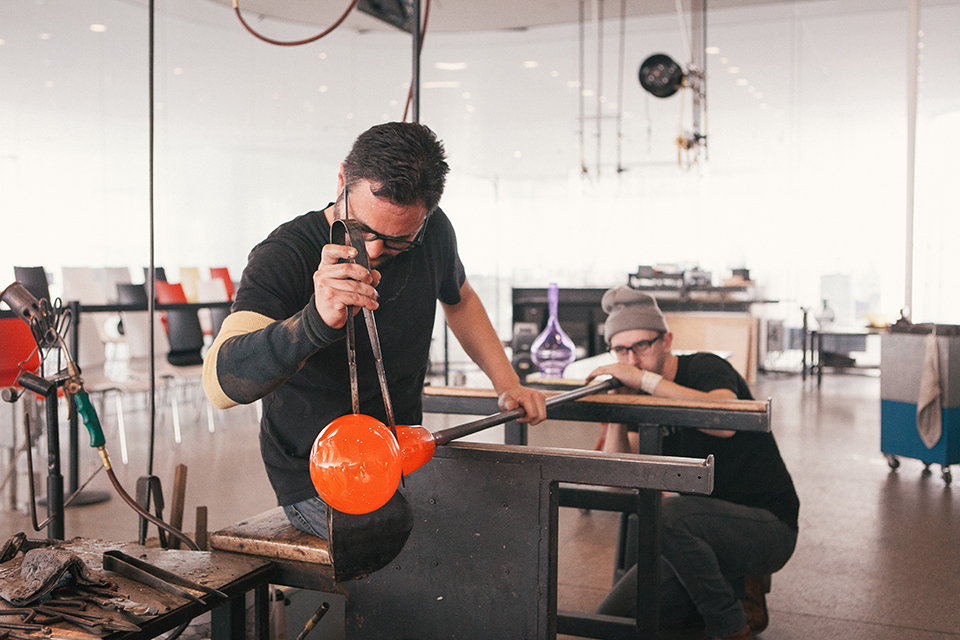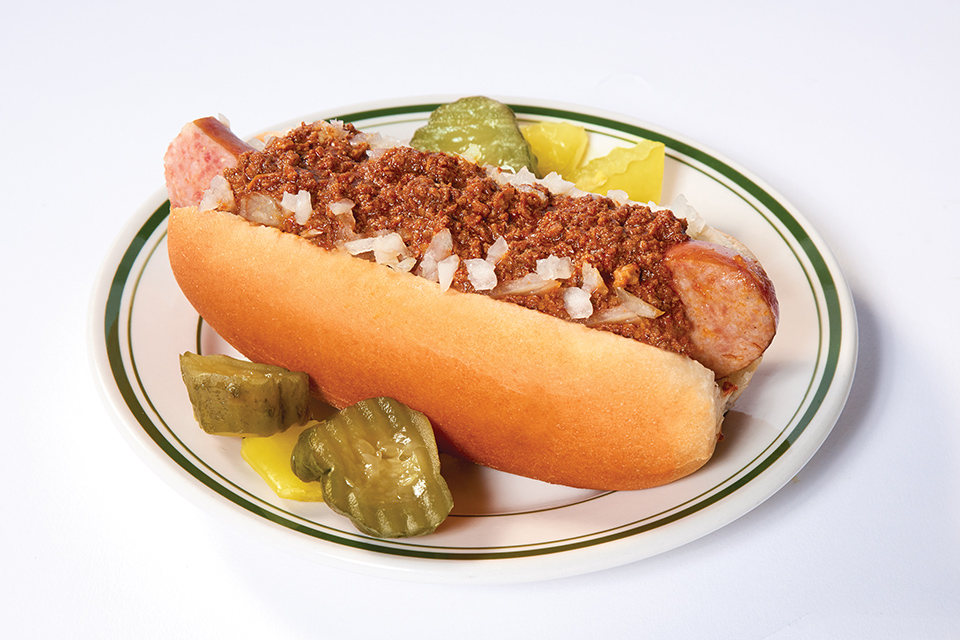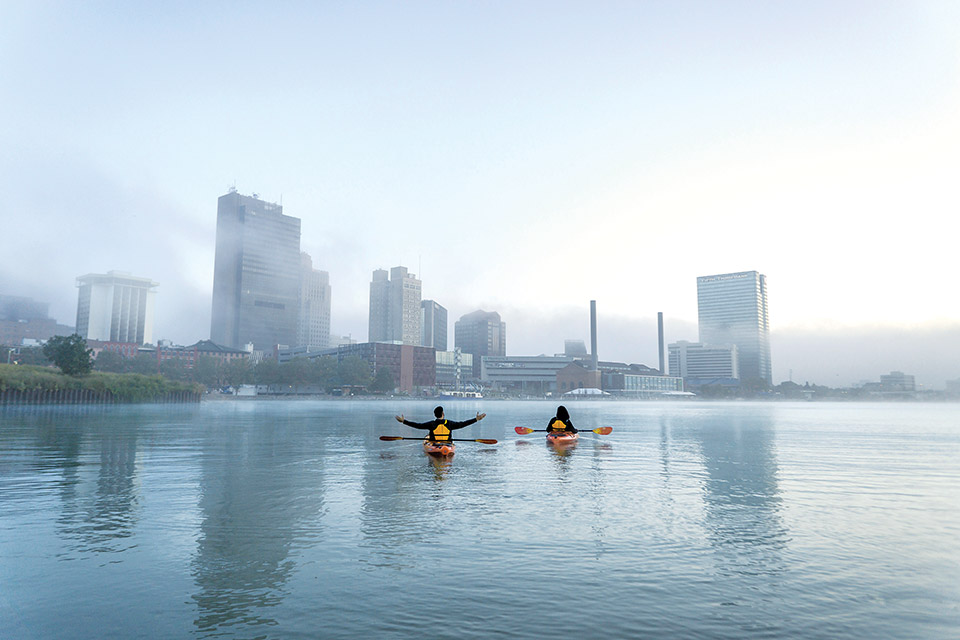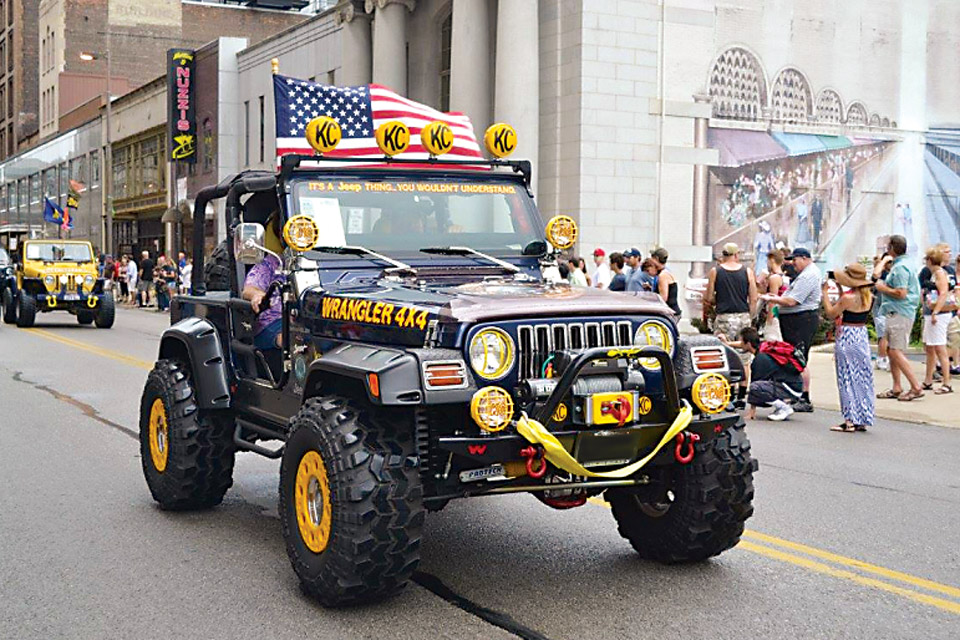Best Things to Do in Toledo, Ohio
This northwest Ohio city along the Maumee River offers a mix of art, nightlife, family fun and outdoor adventure throughout the year.
March/April 2024
BY Ohio Magazine Staff & Contributors | Photo courtesy of Destination Toledo
March/April 2024
BY Ohio Magazine Staff & Contributors | Photo courtesy of Destination Toledo
The city of Toledo gave us the Jeep, studio glass art and the Hungarian hot dog — and you can explore all three during a visit to what is known across Ohio as the Glass City. That rich history comes to life at the Toledo Museum of Art and it’s beautiful glass pavilion, the festival that celebrates Jeep culture each summer and the various Tony Packo’s locations across the city (although we highly recommend first-timers visit the original Front Street location for the full experience.) Whether you want to explore museums, plan an outdoor adventure in one of Metroparks Toledo’s many parks or schedule your visit around a specific time of year, these destinations are just a sampling of all the city has to offer.

Explore Toledo’s Museums & Gardens
Toledo Museum of Art: The Toledo Museum of Art is where the studio glass art movement began. In 1962, local artists were exploring glass as an artistic medium and began offering workshops at the museum with the director’s support, says Diane Wright, the museum’s senior curator of glass and contemporary craft. The museum and its Glass Pavilion are a blend of Toledo’s glass artistry and industry. Libbey Glass, whose owners brought the company to the city of Toledo in 1888, helped to start the museum, and the company continues to help fund the institution today to keep admission free for visitors. The Toledo Museum of Art’s glass collection spans about 8,000 pieces and is one of three major glass collections in the United States, and the works range from ancient to contemporary times. The Glass Pavilion’s Glass Study Room showcases works of glass — both functional and sculptural pieces — from countries around the world. Other popular pieces on display within the pavilion include a life-size glass dress, Tiffany windows and a large glass sculpture by American artist Dale Chihuly. There is also an on-site glass studio where resident artists create their work as visitors watch. 2445 Monroe St., Toledo 43620 , 419/255-8000, toledomuseum.org

National Museum of the Great Lakes: Lake Erie and the other Great Lakes are premier travel destinations, but they’re also filled with secrets waiting to be explored at the National Museum of the Great Lakes. Owned and operated by the Great Lakes Historical Society, the attraction opened along the Maumee River in 2014. More than 250 artifacts — ranging from a wooden tiller from an 1820s commercial sailing vessel to a life raft from the Edmund Fitzgerald, which sank in a Lake Superior storm in 1975 and left no survivors — are popular focal points. New artifacts include an 18th-century swivel gun from a sailing skiff, possibly dating to the French and Indian War. Weather permitting, visitors are invited to step aboard the SS. Col. James M. Schoonmaker moored next to the museum. The freighter, which operated from 1911 to 1914, traversed the Great Lakes, hauling iron pellets to ports in Toledo. Visitors can stand in the pilot’s house, go into the cargo hold where crew placed 15,000 tons of iron ore and see the lounge where the great industrialists of the early 20th century would have stood. 1701 Front St., Toledo 43605, 419/214-5000, nmgl.org
Toledo Botanical Garden Art Village: In 1964, 20 acres of land were deeded to the city of Toledo to form a public park. From that donation came the Toledo Botanical Garden, now part of Metroparks Toledo. During the decade that followed, the garden purchased a neighborhood of homes on nearby Olimphia Road, which became the Artist Village at Toledo Botanical Garden, a series of studios for artists doing glassblowing, pottery, fiber arts and more. The Artist Village also includes space used by the Toledo Potter’s Guild, Toledo Artists’ Club and Unruly Art, a gallery and studio for adults with developmental disabilities. Visitors should be aware that studios in the Artist Village may not always be open or the artists who occupy them may be doing the more mundane parts of their work. The first and third Saturdays of the month are often best for visiting. Those days, you’ll find many artists in their cottages, offering demonstrations and some items for sale. There are also annual events, including a huge plant and pottery sale on Mother’s Day weekend to coincide with National Public Garden Day. 5403 Elmer Dr., Toledo 43615, 419/351-5707, artvillage419.org

Sample Toledo’s Food, Drink and Nightlife
With two minor league sports teams (Toledo Mud Hens baseball and Toledo Walleye hockey), dozens of restaurants and a scenic riverfront, downtown Toledo is a growing and vibrant area with a diverse mix of activities, events and destinations. Outdoor refreshment zones on both sides of the river allow visitors to carry drinks from local restaurants and bars as they walk through downtown. Stay in a room that overlooks the Maumee River at the Renaissance Toledo Downtown Hotel. (444 N. Summit St.) While you’re there, be sure to visit the hotel’s rooftop bar, The Heights, which offers some of the best views in the city along with cocktails and small plates.
Toledo restaurants range from fine dining spots to taverns to delis. Registry Bistro (144 N. Superior St.) serves upscale dishes with a modern Midwestern flair. The menu changes seasonally, but staples like Scotch olives, a Midwestern
meatloaf burger and vegan and gluten-free dishes, are offered year-round. Souk Mediterranean Kitchen & Bar (139 S. Huron St.) serves dishes inspired by those chef Moussa Salloukh grew up eating from his mother’s and grandmother’s
kitchens. Kengo Sushi & Yakitori (38 S. St. Clair St.) brings another flavor to downtown Toledo with its 26-seat bar for sushi and yakitori. A popular experience is the reservations-required Omakase, which means “leave it up to the chef.”
For Irish fare, The Blarney Irish Pub (601 Monroe St.) offers beer-battered fish and chips, house-made corned beef and traditional Irish boxties (potato pancakes with corned beef or salmon), as well as 24 taps of beer. The Adams Street Cafe (608 Adams St.) smokes all its meats, from salmon to turkey to brisket. A popular stop for burgers and sandwiches, the cafe also has standout entrees such as poutine, baked mac and cheese and ramen bowls. For breakfast and lunch, Focaccia’s (333 N. Summit St. #100) offers homemade soups and sandwiches. No visit to Toledo is complete without a trip to Tony Packo’s original
Front Street location (1901 Front St.) for a Hungarian hot dog that the landmark restaurant has made famous.
From distilled spirits
to craft brews, Toledo has plenty of places to enjoy a drink. Downtown’s first brewery, Maumee Bay Brewing Co. (27 Broadway St.), is housed in the historic Oliver House. Rockwell’s Steakhouse is in the same complex. Stop
by Bellwether (1301 N. Summit St.) for handcrafted cocktails made with alcohol from its parent company, Toledo Spirits. (Toledo Spirits opened Heavy Beer Co. in the basement of Bellwether in March 2021.)
For more information about these and other destinations in downtown Toledo, visit downtowntoledo.org. For more information about visiting Toledo, go to visittoledo.org.

Explore Trails on Water and Land
The Ohio Department of Natural Resources designates 11 bodies of water across the state as official water trails. The most recent addition to that list is the Maumee River, which stretches 107 miles from downtown Toledo to the Indiana border. The Maumee River Water Trail’s creation in 2018 involved cooperation between the ODNR, Metroparks Toledo and the Defiance Soil and Water District. The trail is detailed on maps and brochures as well as signs. Those in parks along the trail point travelers to where they can access the river, and signs along the route tell those on the water where they’re headed and detail hazards along the way. The Maumee River Water Trail offers calm spots for beginners as well as whitewater rapids for seasoned kayakers. (Paddlers can bring their own kayak or rent one at Farnsworth Metropark in Waterville. Beginners and recreational kayakers can take advantage of wide sections of the river in the 10-mile stretch from Fort Meigs in Perrysburg to downtown Toledo, a section that more resembles a calm lake than a river. For more information, visit metroparkstoledo.com.
If you’re more interested in staying on land, there are plenty of hiking and biking trails in the region, with the Wabash Cannonball Trail being one of the most prominent. At one point, Toledo was one of the busiest railroad hubs in the United States. The Wabash Railroad ran throughout the area, and the Cannonball was one of its fastest passenger trains. The former railroad rights-of-way are now a 63-mile trail that begins near from Fallen Timbers, the site of a 1794 battle and now part of Metroparks Toledo. For more information, visit wabashcannonballtrail.org.
Spend a Day at Metroparks Toledo’s Downtown Parks
In 2020, the American Academy for Park and Recreation Administration named Metroparks Toledo the No. 1 large park system in the country, beating out Dallas; Mesa, Arizona; and Baton Rouge, Louisiana. It received the Gold Medal award, which takes into account visitation, amenities and experiences offered as well as trail mileage and vision for the future, says Dave Zenk, Metroparks Toledo executive director. Metroparks Toledo also opened its Manhattan Marsh and Glass City parks in 2020. Manhattan Marsh Metropark was the system’s first park in North Toledo. It preserved a wetland that is important habitat and serves as a learning area for students . Manhattan Marsh also fulfills Metroparks Toledo’s promise that all Northwest Ohio residents would have a park location within 5 miles of their home. Glass City Metropark in East Toledo brings a boardwalk along the Maumee River a river walk project that stretches through downtown Toledo. For more information about these parks and others in the Metroparks Toledo system, visit metroparkstoledo.com.

Celebrate Toledo Heritage at Summer Festivals
Toledo Jeep Fest • Early August: Attorney Herman E. Gottfried bought a brand-new butterscotch gold Jeep Wagoneer in 1972 so he could reach his clients in even the most frigid upstate New York weather. After Gottfried’s retirement in 1985, the Jeep rarely traveled far, usually to the golf course or the beach. By the time his nephew, Robert Kramer, inherited the Wagoneer in 2010, it had just 31,000 miles on it. During the 2018 Toledo Jeep Fest, Kramer’s Wagoneer was displayed alongside nearly 100 other historic and unique Jeeps at the SeaGate Convention Centre showroom. The summer event includes a downtown parade of more than 1,000 Jeeps, children’s activities, live music, food tents, beer gardens and Jeep-related vendors. Originally manufactured by Toledo’s Willys-Overland Motors, Jeeps were first conceived as a military vehicle for World War II. Today, the city is home to the Toledo Assembly Complex, which makes the Jeep Wrangler and the Jeep Gladiator. Downtown Toledo 43604, 419/887-6817, toledojeepfest.com
Crosby Festival of the Arts • Late June: Beautiful paintings stand alongside vibrant flowers and handcrafted ceramic bowls rest beneath towering trees as the Toledo Botanical Garden showcases artistic works displayed alongside the beauty of nature’s own creations. The annual Crosby Festival of the Arts, which is sponsored by the local nonprofit Toledo GROWs features 200 artists specializing in a variety of mediums. Each year, a jury of local artists and art experts selects whose work will be showcased from a list of applicants. Although the festival features mostly local talent, artists have traveled from as far as Toronto to take part in the show, which features a wide range of art, including oil paintings, stained glass, ceramics, glass jewelry and sculptures. The three-day festival also includes music, food and a family area with kids activities. 5403 Elmer Dr., Toledo 43615, 419/720-8714, toledogrows.org

German−American Festival • Late August: Thirty-five percent of those who live in Toledo can trace their roots back to Germany. In 1966, the city’s six German and one Swiss ethnic societies created a festival to share
their heritage and traditions with a new generation. Toledo’s annual German-American Festival was so successful that its organizing groups purchased nearly 60 acres in the late 1970s and moved the event to its own grounds in the Lucas County
town of Oregon. After a nearly decade-long decline starting around 2000, organizers revitalized the event in 2008. Since then, they have implemented a larger carnival, two tents for dancing and eating, and a bus system for transporting attendees throughout
northwest Ohio. There’s also live music from Germanic bands, a large wooden dance floor reminiscent of Munich’s Oktoberfest and traditional food, including potato pancakes, schnitzel sandwiches, funnel cakes, bratwurst and pretzels and,
of course, lots of beer. 3624 Seaman Rd., Oregon 43616, 419/691-4116, germanamericanfestival.net
Related Articles

See ’Heartland: The Stories of Ohio Through 250 Objects’ in Lancaster
The Decorative Arts Center of Ohio hosts an artifact-focused exhibition that tells the story of our state through a collection of family keepsakes and iconic inventions. READ MORE >>

Take a Holiday Ride Through History at Spiegel Grove
Horse-drawn sleigh and trolley rides return to the wooded estate of President Rutherford B. Hayes the week after Christmas. READ MORE >>

5 Ohio Holiday Light Displays This Season
From millions of lights found in our zoos, to parks and gardens shining with a warm glow, check out these holiday light displays this season. READ MORE >>



